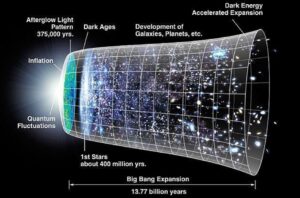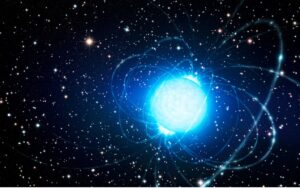
Figure 1: Basic architecture of a rotating black hole. In the middle is the singularity, a one-dimensional point of infinite density (but in a rotating black hole it actually takes the shape of a one-dimensional ring known as a ‘ringularity’). Surrounding the singularity is the event horizon (composed of an inner and outer horizon), inside which gravity is so powerful that nothing can escape. Outside this event horizon is the ergosphere
Source: Wikimedia Commons
Black holes are the most destructive objects in our universe. Astronomers and physicists have theorized that the center of a black hole contains a point of infinite density known as a singularity, which generates an immense gravitational field. So immense, in fact, that nothing, not even light, can escape a black hole’s gravitational pull inside its event horizon. And with this huge gravity comes huge energy. In his 1916 paper on the general theory of relativity, Albert Einstein predicted that rotating black holes have an enormous storage of energy available to be harnessed. But how one can tap into this energy is a whole different question (Columbia University, 2021). Roger Penrose posited that the splitting of matter and a transfer of angular momentum are ways black holes can leak energy—known as the Penrose Process (Mahoney, 2020). And Stephen Hawking theorized that black holes emit energy through quantum mechanical processes—known as Hawking radiation. There are countless other processes that could explain a black hole’s enormous emission of energy, and now, Luca Comisso from Columbia University and Felipe Asenjo from Universidad Adolfo Ibanez in Chile have theorized a new way that involves the reconnection of magnetic field lines (Columbia University, 2021).
Black holes are commonly surrounded by plasma particles that carry a magnetic field, and following the direction of this magnetic field are magnetic field lines. Comisso and Asenjo’s theory is that when magnetic field lines disconnect and connect in a certain pattern, the magnetic energy of the plasma converts to kinetic and thermal energy that can accelerate the plasma particles to negative energies—a theoretical concept that explains the nature of certain fields like gravity. They built this theory on the premise that the reconnection of magnetic fields can accelerate the plasma particles in two different directions. One flow goes against the current of the black hole’s spin and is eventually swallowed, while the other rides in the direction the black hole is rotating, propelled at immense speeds with the possibility that some plasma could escape the clutches of the black hole. However, this flow releases power only if the plasma swallowed by the black hole contains negative energy. As Comisso puts it, “it is like a person could lose weight by eating candy with negative calories.” Essentially, as the black holes swallows negative energy, it has to emit the same amount of positive energy (in the form of the accelerated plasma particles) to follow the laws of conservation. If this process occurs, it could provide an abundant amount of energy for an advanced civilization. This theory might seem like it should remain in the science fiction books, but physicists believe it could happen in the ergosphere of a black hole—a region where space-time rotates so fast that all matter spins in the direction of the black hole. Inside this area, magnetic reconnection is so extreme that plasma particles are accelerated to speeds comparable to light (Columbia University, 2021).
The immense difference in relative velocity between the captured and escaping plasma particles causes the black hole to be an abundant source of energy. In fact, Asenjo and Comisso calculated that if a mechanism was figured out to harness this energy, the process would reach an energy efficiency (a method of using less energy to attain the same output) of 150%, which is more than anything on Earth. This is because the black holes would leak energy themselves, so no work is needed to stimulate the release of energy (Columbia University, 2021; EESI). Asenjo and Comisso’s visions are theoretical, but it could be the practical explanation of black hole flares (bursts of radiation that can be detected on Earth).
These findings could allow astronomers to better predict the spin of black holes, but more importantly, it could become the future of energy. As civilization progresses, the energy available on Earth will not be enough to sustain society’s needs. Humanity may eventually need to look to the sun as it colonizes other planets, and when it becomes a galactic force, the energy inside black holes might be the only viable solution. Asenjo and Comisso’s theory is one of many mechanisms at which black holes could emit energy, and as technology advances, their work might be the key to finding a way to store such energy. The scientists agree that more knowledge is needed about magnetic reconnection if such a method is to become feasible, but with further research, the future of energy could be exciting. As Comisso says, it is “a technological problem. If we look at the physics, there is nothing that prevents it” (Columbia University, 2021).
References
Columbia University. (2021). Could we harness energy from black holes? A new study indicates energy can be extracted from black holes through reconnection of magnetic field lines. ScienceDaily. Retrieved January 18, 2021 from www.sciencedaily.com/releases/2021/01/210113100829.htm
Mahoney, T. (2020). How the Penrose Process Is the Key to Harvesting Energy in the Future. Predict. Retrieved January 18, 2021 from https://medium.com/predict/how-the-penrose-process-is-the-key-to-harvesting-energy-in-the-future-6af3c7767e4f
EESI. Energy Efficiency. Environmental and Energy Study Institute. Retrieved January 18, 2021 from https://www.eesi.org/topics/energy-efficiency/description
Related Posts
UV-Vis Spectroscopy: A Step in the Light Direction
Executive Board Advisor: Nishi Jain Co-Authors: Daniela Galvez-Cepeda, Katherine Faulkner,...
Read MoreAlternative Proposal to the Big Bang’s Singularity Theory: the Hartle-hawking State
Cover: A simulated timeline of the events since the big...
Read MoreNeutron Stars and The Universe’s Strongest Magnet
Figure 1: The image above shows an artist’s depiction of...
Read MoreSai Rayasam



